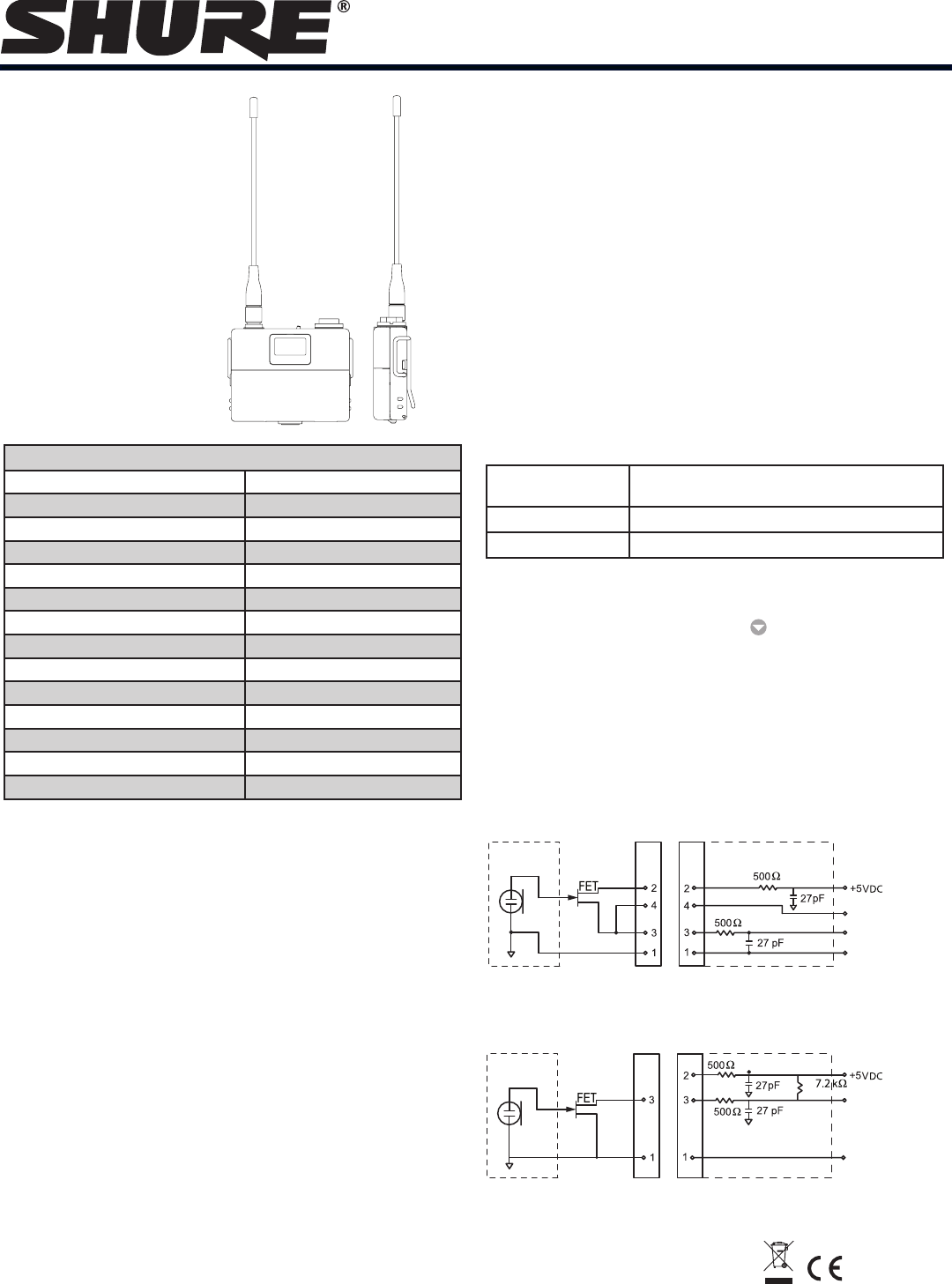Shure orporated UR1MB Micro Bodypack Transmitter User Manual
Shure Incorporated Micro Bodypack Transmitter
User Manual

UR1M Micro Bodypack Transmitter
Addendum
27A11964 (Rev. 1) Printed in U.S.A.
©2008 Shure Incorporated
Specications:
The following specications
apply to the UR1M micro
bodypack only.
Features
Same audio performance as UR1•
Rapid two-way infrared (IR) data transmission•
User-adjustable RF output level (10 mW or 50 mW)•
Operates with two type of primary batteries: alkaline or •
lithium
Audio signal is input through a TA4F connector (UR1M) or •
a LEMO connector (UR1MLEMO3)
Selectable battery metering by battery type•
Audio metering on UR1M transmitter that is the same as •
UR4 receiver
Frequency Range
Band Range
G1 470-530 MHz
H4, H4E 518-578 MHz
J5 578-608, 614-638 MHz
J5E 578-638 MHz
L3E, L3 638-698 MHz
Q5 740-814 MHz
Q6 740-752 MHz
Q9 740-806 MHz
R9 790-865 MHz
R16, R18 794-806 MHz
A24 779-788, 797-806 MHz
JBX 806-810 MHz
X1 944-952 MHz
RF Carrier Frequency Range
470-865, 944-952 MHz depending on region
Working Range
150 m (500 ft.), under typical conditions
500 m (1600 ft.) line-of-sight, outdoors
for a single system
NOTE: Actual working range depends on RF signal absorption,
reection and interference
RF Power Output
10 mW or 50 mW depending on region
Power Requirements:
Two 1.5V AAA alkaline, primary lithium, and NiMH batteries
Current Drain:
130 mA max. at 3V (normal RF power setting)
200 mA max. at 3V (high RF power setting)
Battery Life (Typical):
Alkaline 5 hours (normal RF power)
3 hours (high RF power)
Lithium primary 9 hours, typical
NiMH 3 hours, typical
Select Battery Type:
Set the the micro bodypack transmitter switch to on
Press enter key, then scroll using button to select battery
type. Press enter key to conrm.
Overall Dimensions
49 mm L x 60 mm W x 17 mm D (1.9 x 2.38 x 0.66 in.)
Net Weight
62 g (2.2 oz.) without batteries
Wiring
TA4F Connector
Microphone Element TA4F
Connector
TA4M
Connector
UR1 MIC JACK BOARD
NOTE: LAVALIER MIC TIES PINS 3 AND 4 TOGETHER—GUITAR CABLE DOES NOT.
Active Load
Audio
Ground
LEMO Connector
FVB.00.303 XRB.00.303
UR1 LEMO BOARD
Audio
Ground
Microphone Element
UR1M

UR1M Transmitter RF Output
Connector: SMA
Actual Impedance: 50 Ω
Pin Assignments: Shell = Ground
Center = Signal
UR1M Transmitter Audio Input
Connector: 4-Pin male mini connector
(TA4M)
3-Pin female mini connector
(LEMO XRB.00.303)
Input Conguration: Unbalanced, active
Maximum Input Level:(1 kHz,
1% THD)
+5 dBu (sensitivity 0 dB)
+15 dBu (sensitivity –10 dB)
TA4M Connector Pin
Assignments:
Pin 1: Ground
Pin 2: +5 VDC bias
Pin 3: Audio
Pin 4: Tied through active load
(on main board) to ground.
(On instrument adapter cable,
Pin 4 oats)
LEMO Connector Pin
Assignments:
Pin 1: Ground
Pin 2: +5 VDC bias
Pin 3: Audio
(8.2 kΩ between pin 2 and 3
internal to UR1M)
REPLACEMENT PARTS AND ACCESSORIES
Furnished Accessories
Antenna, 470-530 MHz........................................................UA701
Antenna, 518-578 MHz........................................................UA711
Antenna, 578-638 MHz .......................................................UA721
Antenna, 638-698 MHz .......................................................UA722
Antenna, 740-865 MHz .......................................................UA731
Antenna, 944-952 MHz .......................................................UA741
Optional Accessories
Bodypack Pouch (Black) .................................................. WA581B
Bodypack Pouch (White) ................................................ WA581W
3-Pin mini Lemo conversion kit...........................................WA335
3-Pin mini Lemo Jack for Lavalier ......................................WA336
Assembly Tool for WA336...................................................WA337
Certication
UR1M: Type Accepted under FCC Parts 74 (FCC ID: DD4UR1MA, DD4UR1MB, DD4UR1MC, DD4UR1MF, DD4UR1MG). Certied by
IC in Canada under RSS-123 and RSS-102 (IC: 616A-UR1MA, 616A-UR1MB, 616A-UR1MC). Meets the essential requirements of the
European R&TTE Directive 99/5/EC (ETSI EN 300-422 Parts 1 & 2, EN 301 489 Parts 1 & 9) and is eligible to carry the CE marking.
The “EU Declaration of Conformity” can be obtained from Shure Inc. or any of its European representatives. For contact information
please visit www.shure.com
LICENSING INFORMATION:
Licensing: A ministerial license to operate this equipment may be required in certain areas. Consult your national authority for possible
requirements.
Changes or modications not expressly approved by Shure Incorporated could void your authority to operate the equipment. Licensing
of Shure wireless microphone equipment is the user’s responsibility, and licensability depends on the user’s classication and applica-
tion, and on the selected frequency. Shure strongly urges the user to contact the appropriate telecommunications authority concerning
proper licensing, and before choosing and ordering frequencies.
Information to User
This equipment has been tested and found to comply with the limits for a Class B digital device, pursuant to Part 15 of the FCC Rules.
These limits are designed to provide reasonable protection against harmful interference in a residential installation. This equipment
generates, uses and can radiate radio frequency energy and, if not installed and used in accordance with the instructions, may cause
harmful interference to radio communications. However, there is no guarantee that interference will not occur in a particular installation.
If this equipment does cause harmful interference to radio or television reception, which can be determined by turning the equipment off
and on, the user is encouraged to try to correct the interference by one or more of the following measures:
• Relocate the receiving antenna.
• Increase the separation between the equipment and receiver.
• Connect the equipment into an outlet on a circuit different from that to which the receiver is connected.
• Consult the dealer
This Class B digital apparatus complies with Canadian ICES-003.
Cet appareil numérique de la classe B est conforme à la norme NMB-003 du Canada.
Operation of this device is subject to the following two conditions: (1) this device may not cause interference, and (2) this device must
accept any interference, including interference that may cause undesired operation of the device.
Note: EMC conformance testing is based on the use of supplied and recommended cable types. The use of other cable types may
degrade EMC performance.